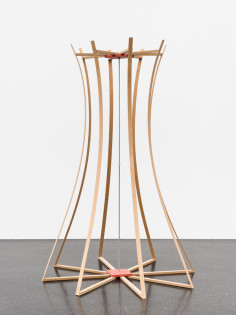Sonia Kacem

source: mamcoch
‘His name was Loulou. His body was green, the tips of his wings were pink, his forehead blue and his throat golden.’ This is how the parrot that keeps poor Félicité company in Flaubert’s short story A simple heart is introduced — a noisy, rowdy parrot that will become ‘almost a son or a lover’ to the abandoned heroine. In the form of a pretty nickname, the title of Sonia Kacem’s exhibition thus refers to a parrot. If we consider what she offers us beneath the bird’s plumage and song, we will note two particular aspects of her work: an orientalising manner and a fondness for repetition and imitation.
Sonia Kacem’s installations are marked by careful attention to materials and the exhibition setting. Describing one of her works often involves combining elements of the technical description with a gesture that makes them spatial: scattering dust, crumpling huge sheets of paper, breaking glass or pottery, bending resin. In this way of experimenting with materials and environments, drapery appears as a favourite motif — not so much the immaculate, flamboyant drapery of the Baroque as the thick, wild, disordered drapery of Delacroix’s orientalist painting — and here it is worth while recalling the remarkable stiffness of the fabrics on which the Romantic painter’s Woman with a parrot is stretched out. The two artists also share a taste for the controlled wrecking of forms, a way of carefully composing chaos — the Swiss artist’s installations Thérèse, Dramaticule or The Waves have something of the strange mastery of entropy that is at work in Death of Sardanapalus.
While spending time in New York this year as an artist in residence, Kacem was able to visit Donald Judd’s actual loft (to which Mamco pays tribute in the exhibition) and rub shoulders with minimalist sculpture (which can be found in the apartment behind the loft). She has borrowed from it the radicality of a primary structure and its theatrical unfolding in space. As in the work of Robert Morris or Carl Andre, situations are constructed between the object-sculpture and the mobile viewer. But, like a Delacroix re-clothing his models after going to Morocco, Sonia Kacem has adorned her structures with old striped awnings. The austere elementary geometry is subverted in motifs suggesting a campsite, a funfair, a refreshment stall or a summer trinket shop. Kacem’s residence in America allowed her to travel to Las Vegas, from which, like Venturi and Scott Brown, she learned lessons: the literalism of form lapses there into monumental pastiche. So the Loulou pyramids are inspired not so much by the Egyptian site at Giza as by that paragon of fakery the giant casino hotel known as Luxor Las Vegas — another orientalist fantasy which, filtered through the world of spectacle, is content to keep on repeating tourist archetypes.
.
.
.
.
.
.
.
source: kunsthallesanktgallench
Sonia Kacem(*1985 in Geneva/CH) studied at the Haute école d’art et de design (HEAD) in Geneva and at the CCW Graduate School, University of the Arts in London. Today she lives and works in Geneva. Solo exhibitions (selection): Musée d’art moderne et contemporain (Mamco), Geneva (2014); Galerie Gregor Staiger, Zurich (2013); La Rada, Locarno (2013); T293, Rome (2013). Group exhibition (selection): Autocenter, Berlin (2014); Miart, Milan (2014); Aanant&Zoo, Berlin (2013); Swiss Art Awards, Basel (2013); Sommer&Kohl, Berlin (2012); Bucharest Biennale 4, Bucharest (2011).
.
.
.
.
.
.
.
source: doppelpunktde
Sonia Kacem (geboren 1985 in Genf) entwickelt teils skulpturale, teils ephemere Tableaux vivants, in denen die Materialitäten und Farben auf ihre kulturellen Erscheinungsformen zurückverweisen und die Betrachter aktiv in ein neues Zeit-Raum-Gefüge einbeziehen. In den Räumen des Kunstvereins Nürnberg präsentiert die Schweizer Künstlerin eine weiterführende Version ihrer großformatigen Installation “Loulou”, die sie letztes Jahr in Genf erstmals präsentierte.

